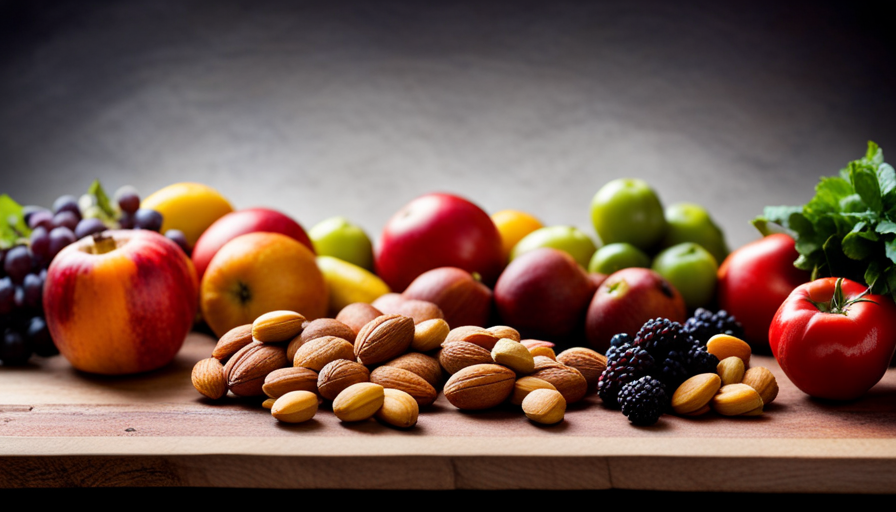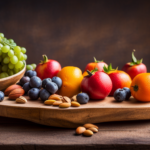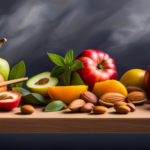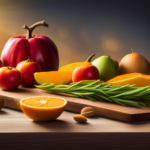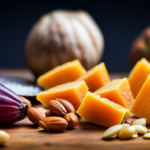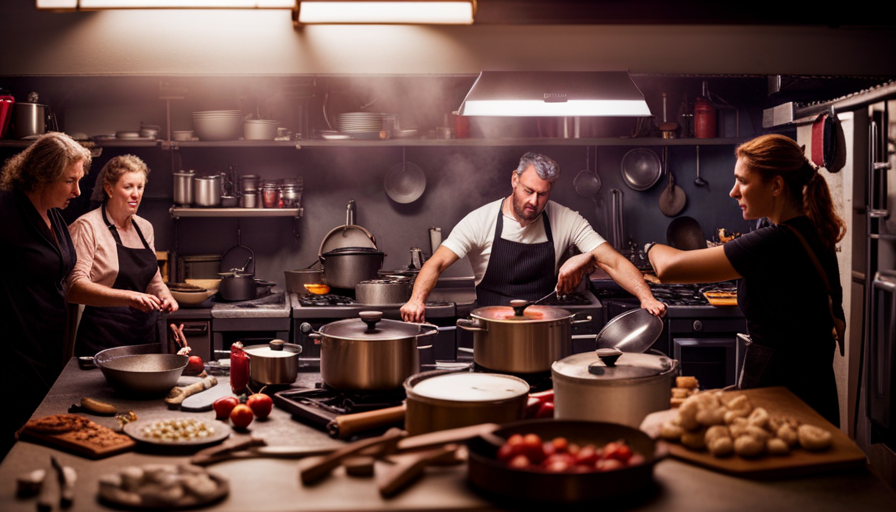As I sat down for my usual cooked meal, I found myself thinking about the growing trend of raw food diets. What is it that captivates people about raw food? Curious, I delved into the world of raw food to uncover its secrets.
Raw food, simply put, is food that is consumed in its natural state, without being cooked or processed. It includes a wide range of fruits, vegetables, nuts, seeds, and even certain meats and dairy products. Proponents of raw food diets claim that it preserves the vital nutrients and enzymes that can be lost through cooking.
But why do people choose to eat raw food? Is there any scientific evidence to support its benefits? And what are the potential risks and considerations?
In this article, I will explore the definition of raw food, its various types, and the reasons behind its growing popularity. I will also discuss the potential risks and considerations associated with raw food diets, and provide tips on how to incorporate more raw food into your diet.
So, let’s embark on this journey together and uncover the truth behind raw food.
Key Takeaways
- Raw food is food consumed in its natural state, without cooking or processing.
- Proponents claim raw food preserves vital nutrients and enzymes lost through cooking.
- Raw food is believed to have high nutritional value, improve digestion, and aid in weight management.
- Proper precautions and planning are necessary when transitioning to a raw food diet.
Definition of Raw Food
So, you’re probably wondering what raw food actually is, right? Well, let me tell you, it’s all about enjoying fresh and unprocessed ingredients in their natural state.
Raw food refers to any food that hasn’t been cooked or heated above a certain temperature, typically around 118 degrees Fahrenheit (48 degrees Celsius). This includes fruits, vegetables, nuts, seeds, and grains.
Raw food enthusiasts believe that consuming food in its raw form has numerous health benefits. One of the main benefits of raw food is its high nutritional value. Raw fruits and vegetables are packed with essential vitamins, minerals, and enzymes that can be destroyed through cooking. These nutrients are vital for our overall health and well-being.
Additionally, raw food is believed to promote better digestion and weight management. Since raw food is rich in fiber and water content, it can help improve digestion and prevent constipation. It’s also lower in calories compared to processed or cooked foods, making it a great choice for those looking to maintain a healthy weight.
Moving on to the next section about types of raw food, it’s important to note that there is a wide variety of options to explore within the raw food diet.
Types of Raw Food
You may think you know all about the various delectable options that await you in the world of uncooked cuisine. Raw food recipes encompass a wide range of ingredients, from fruits and vegetables to nuts, seeds, and sprouts. These unprocessed and uncooked foods are consumed in their natural state, without any heating or cooking methods applied.
One popular type of raw food is the raw salad. Made with a variety of fresh vegetables, such as lettuce, tomatoes, cucumbers, and bell peppers, raw salads are not only delicious but also packed with essential vitamins, minerals, and fiber.
Another type of raw food is the raw smoothie, typically made with a combination of fruits, leafy greens, and water or plant-based milk. These refreshing beverages provide a burst of energy and are a great way to start the day.
The health benefits of raw food are numerous. Since raw foods are not heated, they retain their natural enzymes, which aid in digestion and nutrient absorption. Additionally, raw foods are rich in antioxidants, which help protect the body against harmful free radicals. Raw food enthusiasts often report increased energy levels, improved digestion, and clearer skin.
Now that you have an understanding of the various types of raw food and their health benefits, let’s explore why people choose to eat raw food.
Why People Choose to Eat Raw Food
There are several compelling reasons why individuals opt for a diet consisting primarily of uncooked and unprocessed ingredients. The benefits of raw food are numerous and can have a positive impact on overall health and well-being. Raw food is rich in enzymes, which aid in digestion and nutrient absorption. It is also high in antioxidants, vitamins, and minerals, which help boost the immune system and prevent chronic diseases. Additionally, raw food is typically low in calories and high in fiber, making it an excellent choice for weight management.
However, there are challenges associated with eating raw food. It requires careful meal planning and preparation to ensure a balanced diet that meets all nutritional needs. Raw food diets often lack certain nutrients such as vitamin B12, calcium, and iron, which may require supplementation. Moreover, some individuals find it difficult to adhere to a strict raw food diet due to limited food options and social pressures.
To better understand the benefits and challenges of eating raw food, let’s take a closer look at the table below:
| Benefits | Challenges | Emotional Response |
|---|---|---|
| Improved digestion | Nutritional deficiencies | Excitement |
| Enhanced immune system | Limited food options | Frustration |
| Weight management | Social pressures | Motivation |
| Prevention of chronic diseases | Meal planning difficulties | Determination |
Considering the potential risks and considerations, it is important to make informed decisions when incorporating raw food into one’s diet.
Potential Risks and Considerations
One must be cautious when embracing a diet primarily composed of uncooked and unprocessed ingredients, as there are potential risks and considerations to take into account.
While raw food diets can provide numerous health benefits, it is important to be aware of the potential risks involved. One of the main concerns is the risk of foodborne illnesses, as raw foods may harbor harmful bacteria such as salmonella or E. coli. Proper food handling and hygiene practices are crucial to minimize these risks.
Another consideration is the potential nutrient deficiencies that can occur on a raw food diet. Certain nutrients, such as vitamin B12, iron, and omega-3 fatty acids, are predominantly found in animal-based or cooked foods. It’s important to ensure adequate intake of these nutrients through supplementation or careful meal planning.
Furthermore, raw food diets may not be suitable for everyone, especially those with compromised immune systems or digestive issues. It’s recommended to consult with a healthcare professional or registered dietitian before making significant dietary changes.
While there are potential risks and considerations associated with a raw food diet, with proper precautions and planning, it can be a healthy and sustainable way of eating. Transitioning to a raw food diet should be done gradually and with guidance from a healthcare professional or registered dietitian.
How to Incorporate More Raw Food into Your Diet
To amp up the freshness and nutrition in your meals, try adding more vibrant and unprocessed ingredients to your diet. Incorporating raw food into your meals can have numerous benefits for your health.
Raw food is rich in enzymes, which can aid in digestion and promote overall gut health. Additionally, raw fruits and vegetables are packed with vitamins, minerals, and antioxidants that can boost your immune system and reduce the risk of chronic diseases.
Here are some ways to incorporate more raw food into your diet:
- Start your day with a refreshing green smoothie or a bowl of fresh fruits.
- Include a side salad with every meal, using a variety of colorful vegetables.
- Swap out processed snacks for raw nuts, seeds, or fresh-cut vegetables with hummus.
- Experiment with raw food recipes, such as zucchini noodles or raw vegan sushi rolls.
- Make raw desserts using nuts, dates, and fruits as the main ingredients.
By incorporating more raw food into your diet, you can experience increased energy levels, improved digestion, and enhanced nutrient intake. However, it’s important to note that some raw foods, such as sprouts, may carry a higher risk of foodborne illnesses. Therefore, proper food preparation and storage techniques are crucial to ensure safety.
Tips for Proper Food Preparation and Storage
By mastering the art of handling and preserving your culinary creations, you can safeguard your health and savor the flavors of a well-prepared feast. Proper food preparation and storage are essential when it comes to raw food. The unique nature of raw food requires careful attention to maintain its nutritional value and prevent foodborne illnesses. To ensure proper food preparation, it is crucial to thoroughly wash all fruits and vegetables before consumption. This removes any dirt or bacteria that may be present on the surface. Additionally, using separate cutting boards and utensils for raw and cooked foods helps prevent cross-contamination.
When it comes to food storage, keeping raw food at the right temperature is crucial. Refrigeration slows down the growth of bacteria and helps maintain freshness. It is recommended to store raw food at temperatures below 40°F (4°C) to inhibit bacterial growth. Properly sealing and storing raw food in airtight containers also helps maintain its quality and prevent contamination.
To further assist you in understanding the importance of proper food preparation and storage, here is a table detailing some essential tips:
| Proper Food Preparation Tips | Food Storage Tips |
|---|---|
| Thoroughly wash fruits and vegetables | Store raw food below 40°F (4°C) |
| Use separate cutting boards and utensils for raw and cooked foods | Seal and store raw food in airtight containers |
By following these proper food preparation and storage tips, you can ensure the safety and freshness of your raw food. Now, let’s delve into the common misconceptions about raw food.
Common Misconceptions about Raw Food
Explore the common misconceptions people have about the fascinating world of raw cuisine and discover the truth behind these beliefs.
Raw food has gained popularity in recent years, with many people embracing this lifestyle for its potential health benefits. However, there are several misconceptions surrounding raw food that need to be addressed.
One common misconception is that raw food is boring and tasteless. Contrary to this belief, raw food can be incredibly flavorful and delicious. From vibrant salads to creative smoothies and decadent desserts, there is a wide variety of options to choose from. Raw food also retains its natural colors, textures, and flavors, making it a visually appealing and gastronomically satisfying choice.
Another misconception is that raw food lacks essential nutrients. While it is true that cooking can alter the nutrient content of food, raw food can provide an abundance of vitamins, minerals, and enzymes. Raw fruits, vegetables, nuts, and seeds are nutrient powerhouses that can nourish the body and support overall health.
Incorporating raw food into your diet can also offer numerous benefits, including increased energy levels, improved digestion, weight management, and enhanced skin health. Raw food is packed with antioxidants, fiber, and essential fatty acids, which can contribute to a strong immune system and reduced risk of chronic diseases.
Transitioning into the subsequent section about raw food and sustainability, it is important to consider the environmental impact of our food choices.
Raw Food and Sustainability
While there are common misconceptions about raw food, it’s important to also consider the sustainability benefits and environmental impact associated with this dietary choice.
Raw food has gained popularity due to its potential positive effects on the environment. By consuming raw foods, individuals can reduce their carbon footprint because raw food diets often prioritize locally sourced, organic produce. Additionally, raw food diets tend to minimize packaging waste by promoting the consumption of whole, unprocessed foods. These diets also encourage the use of reusable containers and bags for storing and transporting food, further reducing waste.
Furthermore, raw food diets often involve growing one’s own fruits and vegetables, which can contribute to a more sustainable and self-sufficient lifestyle. Research suggests that the environmental impact of raw food diets may be lower compared to diets that rely heavily on processed and packaged foods.
Considering the potential sustainability benefits and reduced environmental impact associated with raw food diets, it’s clear that this dietary choice has far-reaching implications beyond personal health.
Moving forward, let’s explore the influence of raw food in popular culture and trends.
Raw Food in Popular Culture and Trends
Embrace the latest trends in popular culture by incorporating nutrient-rich, unprocessed ingredients into your daily meals. Raw food has become a popular choice in recent years, with many people exploring the benefits of consuming raw food recipes.
From smoothie bowls packed with fresh fruits and vegetables to colorful salads topped with sprouts and seeds, there are endless possibilities to explore.
In popular culture, raw food has gained attention through documentaries such as ‘Food Matters’ and ‘Super Size Me,’ which highlight the importance of a healthy, plant-based diet. These documentaries showcase the potential benefits of raw food, including weight loss, increased energy levels, and improved digestion.
To delve deeper into the world of raw food, consider watching documentaries that focus specifically on this lifestyle. Films like ‘Simply Raw: Reversing Diabetes in 30 Days’ and ‘Fat, Sick & Nearly Dead’ provide inspiring stories of individuals who have transformed their health through raw food.
Incorporating raw food into your daily routine can be an exciting and rewarding experience. By experimenting with different recipes and incorporating fresh, unprocessed ingredients, you can nourish your body and embrace a healthier way of living.
Transitioning into the conclusion and personal reflection on raw food, it is clear that raw food has gained popularity in popular culture due to its potential health benefits and the inspiring stories shared in documentaries.
Conclusion and Personal Reflection on Raw Food
In conclusion, after exploring the role of raw food in popular culture and trends, I’ve come to a personal reflection on the subject.
Raw food, with its emphasis on unprocessed, whole foods, has gained significant attention in recent years. Proponents of the raw food diet claim numerous health benefits, including increased energy, weight loss, and improved digestion. While there’s some evidence to support these claims, it’s important to approach the raw food diet with caution.
From my personal reflection, I believe that incorporating raw foods into one’s diet can be beneficial, but it shouldn’t be the sole focus. A balanced approach that includes a variety of cooked and raw foods is key to obtaining all the necessary nutrients. Additionally, it’s important to consider individual preferences, lifestyle, and any specific dietary needs or restrictions.
Ultimately, the decision to include raw foods in one’s diet should be based on individual choice and informed by scientific evidence. It’s crucial to listen to our bodies and make choices that support our overall well-being. In this way, we can find a sustainable and enjoyable approach to nutrition that meets our individual needs and goals.
Frequently Asked Questions
Are there any specific health benefits associated with consuming raw food?
There are indeed specific health benefits associated with consuming raw food. Raw food is like a natural medicine, providing us with an abundance of nutrients in their purest form. Raw food recipes can be rich in vitamins, minerals, and enzymes that support digestion and overall well-being.
Additionally, raw food detox diets can help cleanse the body and promote weight loss. Scientific research suggests that raw food diets may reduce the risk of chronic diseases and improve overall health.
Can raw food be cooked or heated in any way?
Raw food can be cooked or heated using various cooking methods. However, it’s important to note that cooking can alter the nutritional content of food. If you’re looking for alternative options to cooking raw food, you can consider using methods like blanching or steaming, which involve minimal heat exposure. These methods can help preserve the natural enzymes and nutrients present in raw food while making it more palatable and easier to digest.
Is it safe to consume raw meat or fish?
Raw meat or fish consumption poses potential risks. Proper handling and storage of raw food are crucial to minimize the occurrence of foodborne illnesses. It’s imperative to acknowledge that consuming raw meat or fish increases the chances of contracting bacterial infections, such as Salmonella or E. coli. To ensure safety, it’s advisable to cook meat and fish thoroughly, as high temperatures kill harmful bacteria.
Adhering to food safety guidelines and cooking practices significantly reduces the risk of foodborne illnesses.
Does the nutritional value of raw food differ from cooked food?
The nutritional value of raw food can differ from cooked food. Raw food, such as fruits and vegetables, can retain more vitamins, minerals, and enzymes compared to their cooked counterparts. However, cooking can also enhance the availability of certain nutrients and make them easier to digest.
When comparing a raw food diet to a traditional diet, it’s important to consider the balance of nutrients and variety of foods consumed. Both diets can be nutritious if well-planned and include a diverse range of foods.
Are there any specific guidelines or recommendations for incorporating raw food into a balanced diet?
When it comes to incorporating raw food into a balanced diet, there are a few guidelines that can help beginners.
Firstly, it’s important to focus on variety and include a wide range of raw fruits, vegetables, nuts, and seeds.
Secondly, it’s recommended to gradually increase the amount of raw food in your diet while still incorporating cooked food for a balanced intake of nutrients.
Lastly, consulting with a registered dietitian can provide personalized recommendations based on individual needs and goals.
How Does Raw Food Relate to the Process of Photosynthesis in Plants?
Raw ingredients for plant food production play a crucial role in the process of photosynthesis in plants. Raw foods, such as fruits and vegetables, provide essential nutrients and energy for plants to undergo photosynthesis, converting sunlight into glucose. This process is vital for the growth and survival of plants.
Conclusion
In conclusion, after exploring the world of raw food, I’m left in awe of its potential benefits and fascinated by the risks it poses.
The contrasting nature of raw food, with its promise of vibrant health and its potential dangers, makes it an intriguing subject to delve into.
While incorporating more raw food into your diet can be a great way to boost nutrition, it’s crucial to consider the potential risks and ensure a balanced approach.
With scientific evidence guiding our choices, we can navigate the world of raw food with knowledge and confidence.

